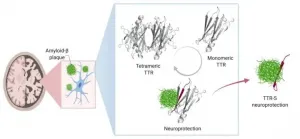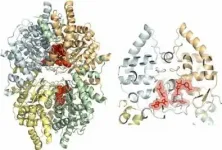New challenges for wolf conservation
2021-01-07
(Press-News.org) People view the wolf as either a threatening predator or a sign of a healthy natural habitat. Many proponents of nature and animal conservation welcome the spread of wolf populations in Germany. By contrast, farmers who graze herds directly impacted by the wolves' return are more critical. The team of Nicolas Schoof, Prof. Dr. Albert Reif of the Chair of Site Classification and Vegetation Science at the University of Freiburg, and Prof. Dr. Eckhard Jedicke of the Competence Center Cultural Landscape and the Department of Landscape Planning and Nature Conservation of Hochschule Geisenheim University has assessed the existing legal situation. On the basis of a range of environmental data they have determined the conflicts and drawn up possible solutions. In an article in the German specialist journal "Naturschutz und Landschaftsplanung" (Nature Conservation and Landscape Planning) the researchers present in detail how wider distribution of the predator could negatively affect legally binding nature conservation goals.
Schoof explains that experts - based on the assumption that the wolves were living mainly in isolation - initially ascribed those that have reappeared in Germany to the Central European Lowlands population. Nevertheless, newer genetic studies show the population is at least interacting with the Baltic wolf population, meaning that incest risk is low. The Freiburg researcher goes on to say that European law is very strict and does not allow - other than has been often maintained - any type of regulatory culling. "As a result," says Schoof, "there is a high growth and survival rate for young animals, allowing the wolf to spread to many regions."
The species itself primarily indicates there has been growth in the native fauna. Schoof's team is analyzing the consequences the growing wolf population - and with it the increasing attacks on livestock and resulting demands to protect herds in Germany - will have for maintaining biodiversity. "There's the threat of a partial abandonment of livestock grazing, especially in locations that are crucial to conserving nature," explains Schoof. Areas affected could, for example, be meadows or grasslands on steep slopes as well as those with stony soils. These habitats are - like the wolf itself - the focus of legally binding conservation measures and are dependent on the continuation of grazing. Unlike the wolf habitats, these environments are so rare that they are at risk.
In many cases, new fences can offer herds much better protection. But this isn't possible on steep slopes, for example. Dependent on the size and condition of the pastures, sheepdogs could be introduced. But the researchers say that is a markedly labor and cost intensive option which would only come into question for a few livestock owners. But sheepdogs cannot be effectively used above all in partially open pasture lands that are an essential component for conserving biodiversity. Yet it is precisely in these areas that the problems caused by wolves could increase, says Schoof, meaning that only fixed, wolf-resistant fences are a solution, but these would limit the spatial efficacy of large grazing projects. What is more, the expected erection of fencing systems will generally form a massive impediment to other wildlife that have found an optimal habitat on grazing land.
Based on these conflicts, the researchers say they have no doubt that the permissible legal regulatory measures to cull problematic individuals through hunting must be simplified significantly and stringently implemented. Taken in perspective, comprehensive active management of the wolf population must be considered and the necessary legal regulatory changes undertaken. The researchers argue that the wolf population is not endangered because of the individual numbers that have been reached, the generally low incest risk, and the current exponential growth in population. Schoof points out that simpler solutions are not in sight or legally possible as yet.
Additionally, the researchers propose in their study that on the one hand, all the required measures to protect herds should be comprehensively supported. "On the other hand, better financial support for the frequently economically unattractive farming of grazing animals could contribute to moderating the existing conflicts," says Schoof. "In that way, owners of grazing livestock would clearly be shown that they are key partners when it comes to implementing practical conservation efforts," he adds.
INFORMATION:
Original publication
Schoof, N., Reif, A., Luick, R., Jedicke, E., Kämmer, G., Metzner, J. (2021): Der Wolf in Deutschland. (The Wolf in Germany.) Herausforderungen für weidebasierte Tierhaltungen und den praktischen Naturschutz. (Challenges for farming grazing livestock and practical natural conservation.) In: Naturschutz und Landschaftsplanung 53 (1), 2021. DOI: 10.1399/NuL.2021.01.01 (in German)
https://www.nul-online.de/Magazin/Archiv/Der-Wolf-in-Deutschland,QUlEPTY3NTk4NjYmTUlEPTgyMDMw.html?UID=EAB591AD28247AD0FD4EF31A8A152961B36F46D6705C
Contact:
Chair of Site Classification and Vegetation Science
Faculty of Environment and Natural Resources
University of Freiburg
ELSE PRESS RELEASES FROM THIS DATE:
2021-01-07
Northeastern Asia has a complex history of migrations and plague outbursts. That is the essence of an international archaeogenetic study published in Science Advances and lead from the Department of Archaeology and Classical Studies at Stockholm University. Genomic data from archaeological remains from 40 individuals excavated in northeastern Asia were explored in the study.
"It is striking that we find everything here, continuity as well as recurrent migrations and also disease-related bacteria", says Anders Götherström, professor at the Center for Palaeogenetics at Stockholm University and one of the Principal investigators of the study.
The ...
2021-01-07
Sleep is ubiquitous in animals and humans and vital for healthy functioning. Thus, sleep after training improves performance on various tasks in comparison to equal periods of active wakefulness. However, it has been unclear so far whether this is due to an active refinement of neural connections or merely due to the absence of novel input during sleep. Now researchers at the Medical Center - University of Freiburg have succeeded in showing that sleep is more than rest for improving performance. The findings, which were published in the journal SLEEP on January 6, 2021, provide important information for planning periods of intensive ...
2021-01-07
January 7, 2021 (BRAMPTON - HAMILTON) -- When dealing with a life-limiting illness, palliative care can improve the quality of life for patients and families. However, for many people, the fear of "end of life" care prevents them from exploring it. A recent study from William Osler Health System (Osler) and McMaster University examined awareness of palliative care in the South Asian community and found that culture plays a critical role in the perception of palliative care. This perception, in turn, affects whether or not patients will be open to receiving it.
Funded by a McMaster University, Department ...
2021-01-07
TORONTO, January 7, 2021- What feels like up may actually be some other direction depending on how our brains process our orientation, according to psychology researchers at York University's Faculty of Health.
In a new study published in PLoS One, researchers at York University's Centre for Vision Research found that an individual's interpretation of the direction of gravity can be altered by how their brain responds to visual information. Laurence Harris, a professor in the Department of Psychology in the Faculty of Health and Meaghan McManus, a graduate student in his lab, found, using virtual reality, that people differ ...
2021-01-07
DALLAS - Jan. 7, 2020 - A protein that wreaks havoc in the nerves and heart when it clumps together can prevent the formation of toxic protein clumps associated with Alzheimer's disease, a new study led by a UT Southwestern researcher shows. The findings, published recently in the Journal of Biological Chemistry, could lead to new treatments for this brain-ravaging condition, which currently has no truly effective therapies and no cure.
Researchers have long known that sticky plaques of a protein known as amyloid beta are a hallmark of Alzheimer's and are toxic to brain cells. As early as the mid-1990s, other proteins were discovered in these plaques as well.
One of these, a protein known as transthyretin (TTR), ...
2021-01-07
Brazilian researchers have managed to decipher the structure of a protein found in parasites that cause neglected tropical diseases, paving the way to the development of novel medications. Thanks to the discovery it will be possible to seek more potent molecules capable of destroying the pathogens directly, with fewer adverse side-effects for patients.
The study detailed the structural characteristics of the protein deoxyhypusine synthase (DHS), found in Brugia malayi, one of the mosquito-borne parasites that cause elephantiasis, and in Leishmania major, the protozoan that causes cutaneous leishmaniasis.
Elephantiasis, also known as lymphatic filariasis, is an infection of the lymph system that can lead to swelling of the legs, arms, and genitalia. It may also harden and ...
2021-01-07
HOUSTON - (Jan. 7, 2021) - Proteogenomic analysis may offer new insight into matching cancer patients with an effective therapy for their particular cancer. A new study identifies three molecular subtypes in head and neck squamous cell carcinoma (HNSCC) that could be used to better determine appropriate treatment. The research led by Baylor College of Medicine, Johns Hopkins University and the National Cancer Institute's Clinical Proteomic Tumor Analysis Consortium (CPTAC) is published in the journal Cancer Cell.
Researchers profiled proteins, phosphosites and signaling ...
2021-01-07
TROY, N.Y. -- In a money-saving revelation for organizations inclined to invest in specialized information technology to support the process of idea generation, new research suggests that even non-specialized, everyday organizational IT can encourage employees' creativity.
Recently published in the journal Information and Organization, these findings from Dorit Nevo, an associate professor in the Lally School of Management at Rensselaer Polytechnic Institute, show standard IT can be used for innovation. Furthermore, this is much more likely to happen when the technology is in the hands of employees who are motivated to master technology, understand their role in the organization, ...
2021-01-07
In a study to examine a Mediterranean diet in relation to prostate cancer progression in men on active surveillance, researchers from The University of Texas MD Anderson Cancer Center found that men with localized prostate cancer who reported a baseline dietary pattern that more closely follows the key principles of a Mediterranean-style diet fared better over the course of their disease.
"Men with prostate cancer are motivated to find a way to impact the advancement of their disease and improve their quality of life," said Justin Gregg, M.D., assistant professor of Urology and lead author of the study, published today in Cancer. ...
2021-01-07
Tsukuba, Japan - Does losing weight while you sleep sound too good to be true? According to a study by the University of Tsukuba, it seems that drinking oolong tea might help you do just that.
While all tea comes from the same plant, Camellia sinensis, the degree of oxidation, a chemical reaction that turns tea leaves black, defines its specific type. For example, green tea is unoxidized and mild in flavor, while the distinctive color of black tea comes from complete oxidation. Oolong tea, being only partially oxidized, lies somewhere in between and displays characteristics ...
LAST 30 PRESS RELEASES:
[Press-News.org] New challenges for wolf conservation

